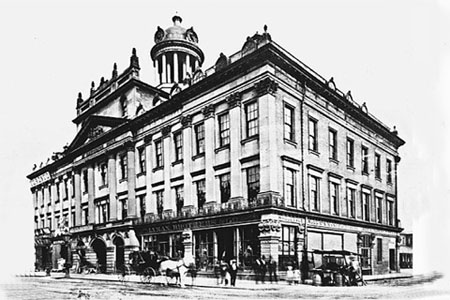This article is from our Toronto Feature series. Features from past programs are not updated.
This content is from a series created in partnership with Museum Services of the City of Toronto and Heritage Toronto. We gratefully acknowledge funding from the Ontario Ministry of Tourism, Culture and Sport, and the Department of Canadian Heritage.
"Anti-Slavery Lecture Opens Hall"
Toronto's great meeting hall and one of its most important historic buildings opened on 1 April 1851 with a lecture entitled "Slavery" delivered by a British Member of Parliament. Later that year, St Lawrence Hall hosted the historic North American Convention of Colored Freemen, where abolitionist leaders such as Henry Bibb discussed the resettlement of refugees from American slavery. Later that year, St. Lawrence Hall hosted the historic North American Convention of Colored Freemen, where abolitionist leaders such as Henry Bibb discussed the resettlement of refugees from American slavery. American abolitionist Frederick Douglass did not attend the Convention of Coloured Freemen at St. Lawrence Hall on 10 September 1851, although he had spoken in Toronto earlier that same year. According to Senior Research Fellow for African Canadian History at York University, Karolyn Smardz Frost, “Douglass was at that point in his thinking adamantly opposed to the emigration of Black Americans to Canada unless they had no other choice. He believed they could combat slavery more effectively from within the US.”
The Toronto convention offered African American leaders a safe haven to meet publicly with abolitionists from Canada, the United States and Britain without fear of violent reprisal.
One of Toronto's most beautiful buildings, St. Lawrence Hall at 157 King St. E was designed by architect William Thomas, otherwise known for Brock's Monument, his famous monument to Sir Isaac Brock at Queenston Heights. Thomas' masterpiece, with its classical Corinthian-columned front and domed cupola, was Toronto's ultimate representation of civic pride. Its grand 30-metre hall witnessed the city's first performance of Handel's Messiah in 1857, and sold out concerts by "Swedish Nightingale" Jenny Lind. Some 500 Reformers met here in the Convention of 1859 and adopted a federation project, which eventually led to Confederation. Other uses included boxing and high-wire demonstrations.
For a number of years St. Lawrence Hall was the home of the National Ballet of Canada. The building was designated a National Historic Site in 1967 and underwent thorough restoration that year as the city's Centennial project.

 Share on Facebook
Share on Facebook Share on X
Share on X Share by Email
Share by Email Share on Google Classroom
Share on Google Classroom


